Best Of CES 2014: Tom's Hardware Recognizes 12 Products
The Best Of CES 2014
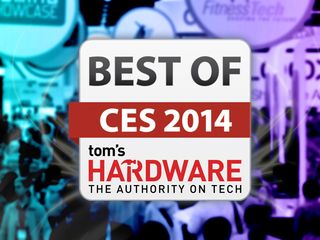
With two million square feet of show floor, CES is the equivalent size of nearly 35 football fields (that's American football, for our international readers) and it attracts thousands of vendors every year.
Given the sheer scale of the show, you're guaranteed to see a lot of old and boring stuff. However, for every one-hundred products that fail to excite, there is one that really gets us going. With the week behind us, our team of PC enthusiasts picked a handful of the most exciting products from CES 2014. Some are revolutionary. Others are simply good ideas we're happy to see in production. And all of them have us excited about the technology we'll be testing in 2014.
Graphics Card: Sapphire Tri-X OC 290
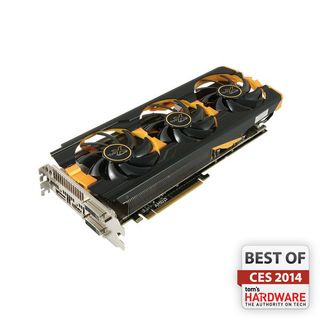
Sapphire announced its custom Radeon R9 290 Tri-X just before CES, right at the end of December, and was showing the card off in Vegas. It snagged our award for a couple of reasons. First, we already saw its closely-related 290X-based stablemate excel in Does Radeon R9 290X Behave Any Differently In A Closed Case? and were really impressed by how well-made the card is. Operating at up to 1 GHz, the Sapphire R9 290 Tri-X is faster than AMD's 947 MHz reference clock rate. It features the same 4 GB of memory, but features a higher data rate of 5.2 GT/s. The big news, of course, is Sapphire’s custom cooling solution, the Tri-X, which has three fans with dust-repelling bearings and aerosol section blades that blow air through a pair of aluminum fin stacks.
Read more about the R9 290 Tri-X here.
Mobile Platform: Nvidia Tegra K1
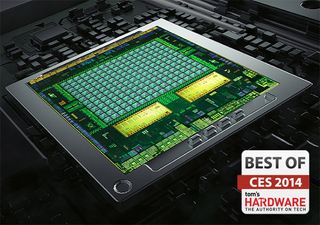
Nvidia's big announcement at CES was its Tegra K1 SoC. The company didn't want to call this part Tegra 5, believing that the shift to a desktop-class graphics architecture is important enough to warrant a departure from previous series naming. Naturally, the K in its name represents Kepler, the same design at the heart of most modern GeForce-based boards.
Although the K1's single SMX is still a far cry from anything you'd find on the desktop, you still get OpenGL ES 3.0, OpenGL 4.4, and DirectX 11 support (along with OpenCL and CUDA for compute). Regardless of whether we're looking at the 32-bit Cortex-A15 or pin-compatible 64-bit Denver version, we have to be impressed by this 5 W SoC's potential in the tablet space.
Stay on the Cutting Edge
Join the experts who read Tom's Hardware for the inside track on enthusiast PC tech news — and have for over 25 years. We'll send breaking news and in-depth reviews of CPUs, GPUs, AI, maker hardware and more straight to your inbox.
Case: Zalman AHV Computer Case Z15
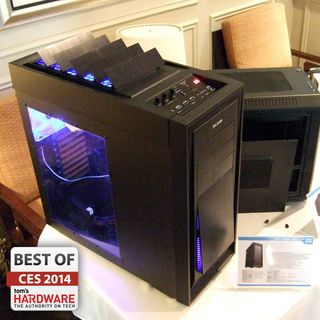
The AHV (Automatic Heat Ventilation) system was unique among end-user cases at CES 2014, giving enthusiasts a choice between manual and temperature-based motorized vent actuation. Smooth black anodized panels switch to a radical fin orientation based upon those selections, where the closed configuration also helps contain noise at lower thermal loads.
For many gamers, GPU heat will most likely actuate the thermal controls, turning Zalman's sedan into a spoiler-deployed sports car. Ideally, you'll already be blasting away with your headset on, unable to discern any additional noise as the panels open up.
Read more about Zalman's AHV Z15 case here.
Storage Device: LaCie Little Big Disk Thunderbolt 2
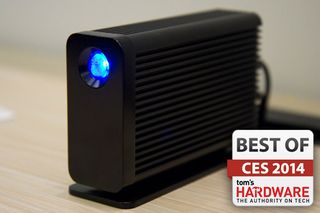
We got a chance to go hands-on with LaCie's Little Big Disk Thunderbolt 2 at CES 2014. The company is known for being ahead of the curve when it comes to Thunderbolt-enabled peripherals. With the introduction of Thunderbolt 2, LaCie is once again leading the charge.
This thing is tiny and beautiful. It keeps cool through an aluminum enclosure and small fan. Under the hood, you’ll find a pair of Samsung XP941 PCIe-based M.2 SSDs connected through a PCIe switch and configured in a RAID 0 array through software (there is no hardware RAID functionality). Thunderbolt 2 allows for a single 20 Gb/s channel, as opposed to two 10 Gb/s links, allowing read and write performance to hit 1300 and 1000 MB/s, respectively.
Read more about Lacie's Little Big Disk Thunderbolt 2 here.
Gaming Peripheral: Corsair Cherry MX RGB
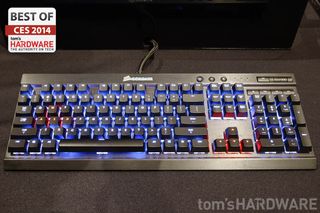
Corsair sent us word of its Cherry MX RGB mechanical keyboard ahead of CES, and we made a beeline for it when the show opened. It’s the world’s first gaming keyboard with Cherry MX RGB key switches, facilitating backlighting in 16.8 million colors. It should go on sale later this year with Cherry MX Red, Cherry MX Brown, or Cherry MX Blue switches.
Read more about the Corsair Cherry MX RGB mechanical keyboard here.
Notebook: Lenovo Carbon X1
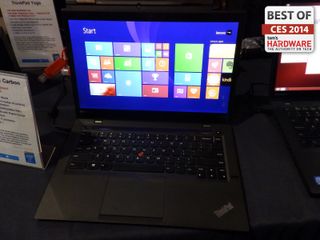
The ThinkPad X1 Carbon was one of the many products that Lenovo announced at CES 2014. The machine is a second-generation offering (the first debuted during the summer of 2012). It has the same soft touch carbon fiber chassis, but it’s slightly smaller and lighter than the original. Lenovo added a touch-sensitive strip over the keyboard displaying shortcut keys that change depending on the application you have open. This is a clear improvement over the single-function hardware keys on the previous version. There’s also native Ethernet and OneLink Docking, touch or non-touch displays, Windows 8.1 Pro, Intel’s Haswell-based CPUs, and longer battery life. It’s arriving later this month and starts at $1300.
Read more about the Lenovo X1 Carbon here.
Automotive: 2015 Hyundai Genesis Sedan With Blue Link
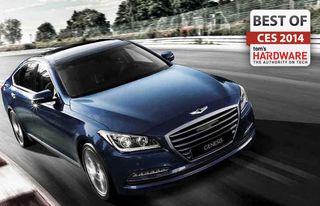
With mobile devices and wireless connectivity more pervasive than ever, car companies have a lot to live up to. Hyundai is embracing technology integration with its 2015 Genesis Sedan. Blue Link has new features that seem genuinely useful. The Genesis Assistant app is quick and responsive; there’s no long delay after the car receives commands, as before. There's even a Google Glass app that can remotely start, unlock, and find your car. The Genesis looks great and launches later this year.
Monitor/Display: Asus ROG Swift PG278Q
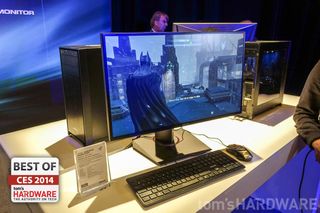
There's a new game-changing technology in town, and it's Nvidia's G-Sync. Asus backed this technology with real hardware right at launch, and at CES the company rolled out a follow-up in its ROG Swift PG278Q. This is a 27-inch display with a 2560x1440 native resolution at 120 Hz. Yes, we're still talking about a TN panel. However, display quality in Asus' suite was markedly better than the engineering sample that Angelini tested for his launch coverage. The ROG Swift PG278Q is big, fast, and perfect for the gamer with a compatible GPU, all for $800.
Read more about the ROG Swift PG278Q here.
Learn all about Nvidia G-Sync here.
Are you an AMD fan? Check out the details on FreeSync.
Platform: Gigabyte Brix Pro
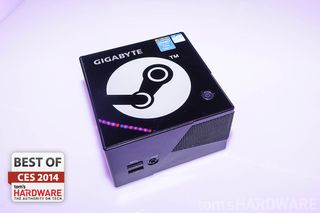
We're no strangers to Gigabyte's Brix Pro. But for CES, the company unveiled an official Steam Machine version. Under the hood, you're looking at an Intel Core i7-4770R and Iris Pro graphics 5200 (actually, you'll have a choice between the Core i7-4770R or Core i5-4570R), and the Brix Pro will ship with a mini-PCIe Wi-Fi module installed.
Read more about the Gigabyte Brix Pro here.
Mobile Device: Huawei Ascend Mate 2 With LTE
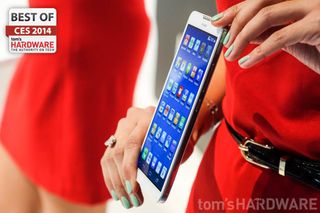
Huawei's Ascend Mate 2 is the follow-up to last year's massive Ascend Mate. Though the phone's general specs don't change much, its stand-out feature is its USB charger functionality. That's right, the Ascend Mate 2 can actually charge your other devices. The built-in battery is 4050 mAh, which is supposedly good for 60 hours of "normal" use or 12 hours of Web browsing. That's impressive when you consider that most smartphone batteries don't last one day of anything beyond moderate use.
-
vertexx Not too sure about the Sapphire choice. MSI IMO has the best set of coolers this year. Based on some reviews out there, it looks like they have the best 780ti card IMO. Will be looking forward to the head to head matchups for 290x.Reply -
hasappra ReplyNot too sure about the Sapphire choice. MSI IMO has the best set of coolers this year. Based on some reviews out there, it looks like they have the best 780ti card IMO. Will be looking forward to the head to head matchups for 290x.
This version Tri-X is the new cooler from Sapphire and it really is probably the best open air cooler that exist today. Furmark temp only 74C with noise only 43dB. That's awesome. You can read its preview in http://www.anandtech.com/show/7601/sapphire-radeon-r9-290-review-our-first-custom-cooled-290 -
house70 Corsair Cherry MX RGB? Forums are filled with people that have reported problems with their backlit keyboards. LEDs that last a couple weeks, then go out. I give them props for using mechanical switches, but that's where the props end (and it's not even something innovative, has been done for decades). As far as backlighting goes, they have the worst record by far. Just because something is shiny doesn't mean it gets the prize. It needs to withstand the test of time, and I would take any Corsair KB praise with a huge grain of salt.Reply -
eklipz330 that monitor is something else... too bad im gonna stay with AMD because of freesynchoping to snag a xl2420z when it hits shelves!Reply -
xyster That monitor is hot. While AMD might have freesync, it sounds to me like freesync is a backhanded attempt to catch up with Nvidia on their innovation. Even if freesync does catch on, it should be compatible with Gsync monitors, no?, so why not just get something now that offers longterm flexibility in terms of options instead of waiting to see. if only they could get IPS and lightboost somehow added in.. mmmm..Reply -
xyster That monitor is hot. While AMD might have freesync, it sounds to me like freesync is a backhanded attempt to catch up with Nvidia on their innovation. Even if freesync does catch on, it should be compatible with Gsync monitors, no?, so why not just get something now that offers longterm flexibility in terms of options instead of waiting to see. if only they could get IPS and lightboost somehow added in.. mmmm..Reply -
Serpent of Heaven ReplyThat monitor is hot. While AMD might have freesync, it sounds to me like freesync is a backhanded attempt to catch up with Nvidia on their innovation. Even if freesync does catch on, it should be compatible with Gsync monitors, no?, so why not just get something now that offers longterm flexibility in terms of options instead of waiting to see. if only they could get IPS and lightboost somehow added in.. mmmm..
Free-Sync is apart of the VESA Standards. In theory, I could also be used with TVs, other displays, and laptops. This could also be used by your PS4 and Xbox Ones because of the AMD APUs is running the heart of the consoles. All hardware from the AMD 5000 Series and above, can utilize Free-Sync with the help of a Driver.Free-Sync is just one of many techs AMD had hiding on the side for the past 3 years. Some other examples would be Stacked Ram on the GPU like NVidia's Volta. Volta is the successor to Maxwell. AMD has already researched and made prototypes a few years go. They are just allowing NVidia to market these goodies for them because they are good at making a "big deal" about those new types of techs. AMD doesn't need to do a lot of work with the PR of the products when NVidia throws $$$ at the publicity of similar innovations. This equates to saving money on AMD's end.The ROG monitor is nice, but it's a TN panel. It will have it's up and downs with the addition of NVidia's G-Sync. Plus, besides that $799.99 price tag, you'll have to run firmware and driver updates for G-Sync with the NVidia WHQL and Beta Drivers. Translation: Don't expect it to work 100% up to specifications, all the time. There is bound to be some drivers that will cause issues with G-Sync. The same could be said about Free-Sync, but with all bases, a majority believe that AMD Drivers are still pretty bad. Lately, they've actually been getting better and better. -
somebodyspecial For those who don't like clicking a dozen pics...The Best Of CES 2014 Graphics Card: Sapphire Tri-X OC 290 Mobile Platform: Nvidia Tegra K1 Case: Zalman AHV Computer Case Z15 Storage Device: LaCie Little Big Disk Thunderbolt 2 Gaming Peripheral: Corsair Cherry MX RGB Notebook: Lenovo Carbon X1 Automotive: 2015 Hyundai Genesis Sedan With Blue Link Monitor/Display: Asus ROG Swift PG278Q Platform: Gigabyte Brix Pro Mobile Device: Huawei Ascend Mate 2 With LTE Outside The Box: Razer Project Christine Most Innovative Technology: Oculus RiftReply -
cats_Paw Rift Rift and again Rift.All the other products seem flashy with a lot of marketing, but no real innovation.Tegra K1 looks promissing no doubt but its yet to see what it can do.Reply
Most Popular

